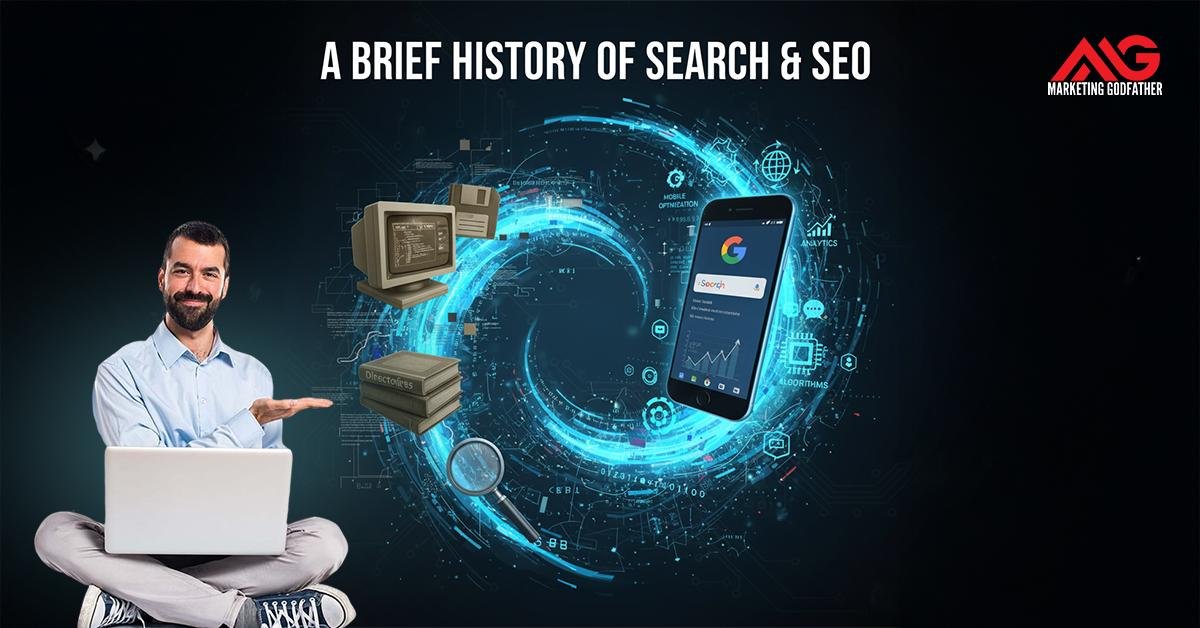The history of search & SEO is the story of how the internet learned to organise itself. In the early days of the web, information existed like scattered islands, hard to find and poorly connected. Then came search engines, transforming chaos into structure. But as soon as people realised that visibility meant opportunity, Search Engine Optimisation (SEO) was born.
Early Search Tools of the 1990s (Archie, AltaVista, and Yahoo!)
The journey of search truly began in the early 1990s, when pioneers started building digital indexes to organise the web’s growing content.
- Archie: launched in 1990, was the first known search tool, though it wasn’t quite a search engine as we know it today. It indexed FTP (File Transfer Protocol) sites, allowing users to look up specific file names, not webpage content. Still, it marked the beginning of structured web search.
- AltaVista: launched in 1994 and introduced a major leap forward. It allowed users to search full-text pages and delivered lightning-fast results compared to its competitors. AltaVista also pioneered the concept of web crawling, indexing millions of pages and making search accessible to ordinary users for the first time.
- Yahoo: Around the same time, Yahoo started as a human-curated directory rather than an automated search engine. Its approach focused on categorising websites by topic, giving users a sense of structure in an otherwise chaotic online world.
The Rise of Google and the PageRank Revolution
By the late 1990s, the web had become massive and messy. Existing search engines like Yahoo! and AltaVista relied heavily on keyword matching, often leading to irrelevant or spammy results. Then, in 1998, two Stanford PhD students, Larry Page and Sergey Brin, launched Google, introducing a breakthrough concept that would redefine how search worked.
How Search Algorithms Transformed the Web?
Search algorithms changed everything about how we experience the internet. In the early 2000s, Google’s PageRank wasn’t just about ranking pages; it was about shaping the way websites were built. Suddenly, content quality, site structure, and backlinks became the pillars of online visibility.
The Evolution of SEO
As search engines evolved, so did the strategies to rank within them. The early 2000s marked the beginning of a new digital era, one where Search Engine Optimisation (SEO) became essential for online success. What started as simple keyword manipulation soon turned into a complex discipline combining content strategy, user behaviour, and algorithm understanding.
The Dawn of SEO: The Keyword Stuffing Era
In the late 1990s and early 2000s, SEO was still in its wild west phase. Search engines like AltaVista and early Google versions mainly ranked pages by how often a keyword appeared. This led to the infamous “keyword stuffing era,” where website owners would cram keywords into every possible space, titles, footers, meta tags, and even invisible text.
Introduction of Link Building and Authority Signals
Each link was treated as a vote of confidence. A backlink from a trusted source, like a university or major publication, weighed far more than a random directory link. This gave rise to the era of authority-based SEO, where webmasters focused on earning reputable links rather than flooding pages with keywords.
The Shift Toward Content Quality and Relevance
By the late 2000s, search engines had matured, and so had user expectations. People no longer wanted to scroll through keyword-stuffed pages; they wanted useful, relevant, and engaging content. Google responded by evolving its algorithms to reward content quality over keyword frequency.
Google Algorithm Updates That Shaped SEO
Google’s algorithm updates are the milestones that shaped modern SEO. Each major update changed how websites were ranked, forcing marketers to adapt their strategies and focus on what truly mattered: user experience, content quality, and trustworthiness. In the early years, updates were small and technical, but as the web exploded with content, Google needed smarter ways to filter value from noise.
That’s when updates like:
- Panda, Penguin, and Hummingbird:
Between 2011 and 2013, Google rolled out three revolutionary updates: Panda, Penguin, and Hummingbird, each of which permanently changed how SEO worked. These weren’t minor tweaks; they redefined the very foundation of search rankings.
- RankBrain and AI Integration:
Google took another giant step toward intelligent search by introducing RankBrain, its first-ever AI-driven algorithm. RankBrain marked the beginning of a new era where machine learning became an integral part of how search engines understood users.
- Core Web Vitals and the User Experience Focus:
Core Web Vitals in 2021 officially made site performance a ranking factor, emphasising how users feel when they interact with a webpage.
Core Web Vitals measure three critical aspects:
- Largest Contentful Paint (LCP): how quickly the main content loads.
- First Input Delay (FID): how soon a page responds to a user’s first action.
- Cumulative Layout Shift (CLS): how stable a page’s layout is while loading.
The Modern SEO Landscape
Today’s SEO is a dynamic, multi-dimensional field far removed from the days of keyword stuffing and directory links. The modern SEO landscape blends technology, creativity, and psychology to meet the demands of both algorithms and audiences.
Mobile-First Indexing and Voice Search Optimisation
As smartphones became the primary gateway to the internet, Google made one of its most defining moves, introducing mobile-first indexing. This meant that Google began prioritising the mobile version of a website when crawling and ranking pages, recognising that the majority of searches now happen on handheld devices.
AI and Machine Learning in SEO
Artificial Intelligence (AI) and Machine Learning (ML) have become the driving forces behind modern SEO. What once relied on static algorithms and human adjustments is now powered by self-learning systems that adapt in real time to user behaviour and search trends.
The Future of Search: Predictive and Personalised SEO
The future of SEO is no longer about reacting to trends; it’s about predicting them. As AI and big data evolve, search is becoming increasingly popular. Personalised search means no two users see the same results. Google’s systems now consider a mix of search history, device type, and context, crafting experiences that feel tailor-made.
Final Thoughts: What the Evolution of SEO Reveals
From the crude keyword experiments of the 1990s to today’s AI-driven algorithms, the journey of SEO mirrors the evolution of the internet itself from information overload to intelligent discovery. The future of search will be more predictive, more personalised, and more immersive than ever. Yet, the essence remains unchanged: users seek clarity, relevance, and value. Those who craft content with empathy, supported by data and creativity, will continue to lead in the ever-changing digital landscape.

